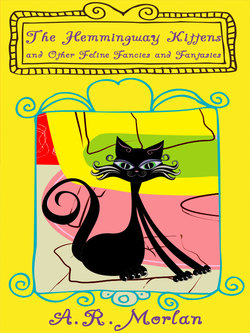Читать книгу The Hemingway Kittens and Other Feline Fancies and Fantasies - A. R. Morlan - Страница 5
На сайте Литреса книга снята с продажи.
ОглавлениеINTRODUCTION
A CAT OF NINE TALES
My very dear late friend, Ardath Mayhar, was one of those individuals who not only nurtured within her an immense literary talent that found expression in her own novels, stories, and poems, but also somehow managed to act as a catalyst for other voices just emerging from their creative chrysalides. She accomplished this partly by providing, in her last decades, private professional editorial advice for a variety of old and new writers.
Hence, when David Feintuch was trying to shape his first novel, Midshipman’s Hope, into something that might be publishable, she was able to tender some suggestions that helped move that project forward to a successful conclusion.
From my own dealings with her, it was clear that she knew just what to say to the wide range of correspondents and friends who brought so many literary gifts to lay at her feet. She helped make their work better. She helped make them better. She was a positive force who accomplished a great deal of good from her self-built metal house in the middle of the East Texas muddle from which she came.
I have no idea how many artists Ardath influenced, but the number seems to grow with my knowledge of the field, with the expansion of my own network of authors and agents and editors.
A.R. Morlan was one of her friends and colleagues way back when, long before I’d encountered either writer—and now I’m privileged to count “A.R.” among my own dear friends.
This is a woman of enormous talent, whose fiction is utterly without compare among modern American masters. She sees things that no one else sees, she finds connections that no one else has ever imagined, and she makes her prose sing and vibrate with a barely constrained but firmly disciplined power, with immense feeling, with great sympathy for the all-too-human characters who people her literary worlds.
She is, in my estimation, one of those authors who will someday, long after she and I are both gone, be “discovered” by the critics, and acclaimed as a modern master of the short story form. Dissertations will be written about her work, and pundits will nod their heads in affirmation, muttering “Yes, yes.” But all that future discussion and all that future popularity will not penetrate even a millimeter into the complexity of her work, the sheer scope and breadth and depth of it. Nor should it.
This collection includes some of my favorite Morlan tales—only because both Mary and I are, quite simply, “animal crackers”—just like A.R. We live for our critters, who return our love with a devotion that none of us can ever imagine. Both cats and dogs have adapted themselves symbiotically to human beings, and one wonders sometimes, in watching them cavort for us, in experiencing the sheer joy of their existence, who is the master here—and who the mastered. Perhaps it signifieth not.
A.R.’s love for her cats is evident in her work—and in her life. Her love for her writing is equally clear. This is what she was meant to do—always. This is who she is—always. Through adversity, through experiences that would have destroying a lesser individual, through pain and sorrow and way too much travail, she has persevered; and what you read in this little volume of tales, what you see in her other collections that Mary and I have edited, synthesizes the essence of that large spirit that has somehow survived the Trials of Job.
I think her cats did it. I really do. I think they appeared to provide her with just what she needed. Alas, Ardath Mayhar is no longer with us to give us solace and advice and love. She did what she needed to do—and then she left her corpus of work to remind us of what we needed to do.
But it was the cats, the spirits of all the writers and creative folk who’ve ever lived, who yet remain. Who is the master? Who is the mastered?
Is it the cat of nine tales? Mirabile dictu!
—Robert Reginald,
June 6, 2013
